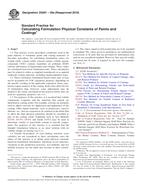Potřebujeme váš souhlas k využití jednotlivých dat, aby se vám mimo jiné mohly ukazovat informace týkající se vašich zájmů. Souhlas udělíte kliknutím na tlačítko „OK“.
ASTM D5201-05a(2010)
Standard Practice for Calculating Formulation Physical Constants of Paints and Coatings (Includes all amendments And changes 12/5/2014).
Automaticky přeložený název:
Standardní praxe pro výpočet Formulace fyzikálních konstant barev a nátěrů
NORMA vydána dne 1.2.2010
Informace o normě:
Označení normy: ASTM D5201-05a(2010)
Poznámka: NEPLATNÁ
Datum vydání normy: 1.2.2010
Kód zboží: NS-30256
Počet stran: 6
Přibližná hmotnost: 18 g (0.04 liber)
Země: Americká technická norma
Kategorie: Technické normy ASTM
Anotace textu normy ASTM D5201-05a(2010) :
Keywords:
density, formulation, HAP, hazardous air pollutant, physical constants, solids content, VOC, volatile organic compound, Solvents--paints/related coatings/materials, Weight solids, Calculating test values, Density--paints/related coatings/materials, Formulation physical constants, Physical analysis/characterization, Solid phase materials--paints/related coatings/materials, Solventborne paints/coatings, Volatile organic compounds (VOC)--paints/related coatings, Volume solids
Doplňující informace
| Significance and Use | ||||||||||||||||
|
Physical constants of paints and coatings are required in all aspects of their formulation, manufacture and use. This practice demonstrates standard methods agreed upon for calculating formulation values for some of these physical constants. The calculations are the same for either metric or inch/pound units. These formula values may not be used to replace measured values required by government regulations unless specifically stated in the governing documents. Some regulations allow compliance determination using formulation data instead of analytical data. This formulation data may not yield the same results as the required analytical method, which could be performed on a sample from any production batch of the coating. In these cases, the user may wish to compare formulation data to analytical data and develop a factor that adjusts for variability of raw materials, variability of production batches, cure volatiles, and variability of the analytical methods. |
||||||||||||||||
| 1. Scope | ||||||||||||||||
|
1.1 This practice covers procedures commonly used in the paint industry to formulate paints and coating materials. It describes procedures for calculating formulation values for weight solids, volume solids, solvent content, volatile organic compound (VOC) content, hazardous air pollutant (HAP) content, and density of liquid paints and coatings. These values are calculated from basic formulation data. These calculations may be related to either as-supplied (unreduced) or as-applied (reduced) coating materials, including multicomponent types. 1.2 These calculated, formulation-based values may or may not be acceptable for VOC regulatory purposes, depending on the specific wording of the applicable regulation. Some regulations require analysis of the coating. Some rules allow the use of formulation data, however, some adjustments may be needed to the values calculated in this practice before they are used for regulatory purposes (see 4.3). 1.3 For purposes of this practice, it is assumed that volatile components evaporate and the materials that remain are identified as coating solids. For example, solvents are normally used to adjust viscosity for application and appearance of the coating. Other liquid materials, such as plasticizers, reactive diluents, etc., that are expected to be retained in the dried film to affect the final physical properties should be classified as part of the coating solids. Standards such as Test Methods D2369, D4758, D5403 and Guide D2832 may be used to determine volatile or nonvolatile content of specific components. For purposes of this practice it is assumed that the blended formulation behaves as an ideal solution with no volume change on mixing (see 6.2). 1.4 Volatile by-products of cross-linking reactions (cure volatiles) are not considered in these calculations since the object of this practice is to define paint physical constants based on formulation information. Variations in raw materials, variations in the production processes, test methods, and test method accuracy are not taken into account in these calculations. 1.5 The values stated in inch-pound units are to be regarded as standard. The values given in parentheses are mathematical conversions to SI units that are provided for information only and are not considered standard. However, they may be readily converted into SI units, if required by the user (for example, see Note 4). |
||||||||||||||||
| 2. Referenced Documents | ||||||||||||||||
|
Doporučujeme:
Aktualizace technických norem
Chcete mít jistotu, že používáte pouze platné technické normy?
Nabízíme Vám řešení, které Vám zajistí měsíční přehled o aktuálnosti norem, které používáte.
Chcete vědět více informací? Podívejte se na tuto stránku.




 Cookies
Cookies
